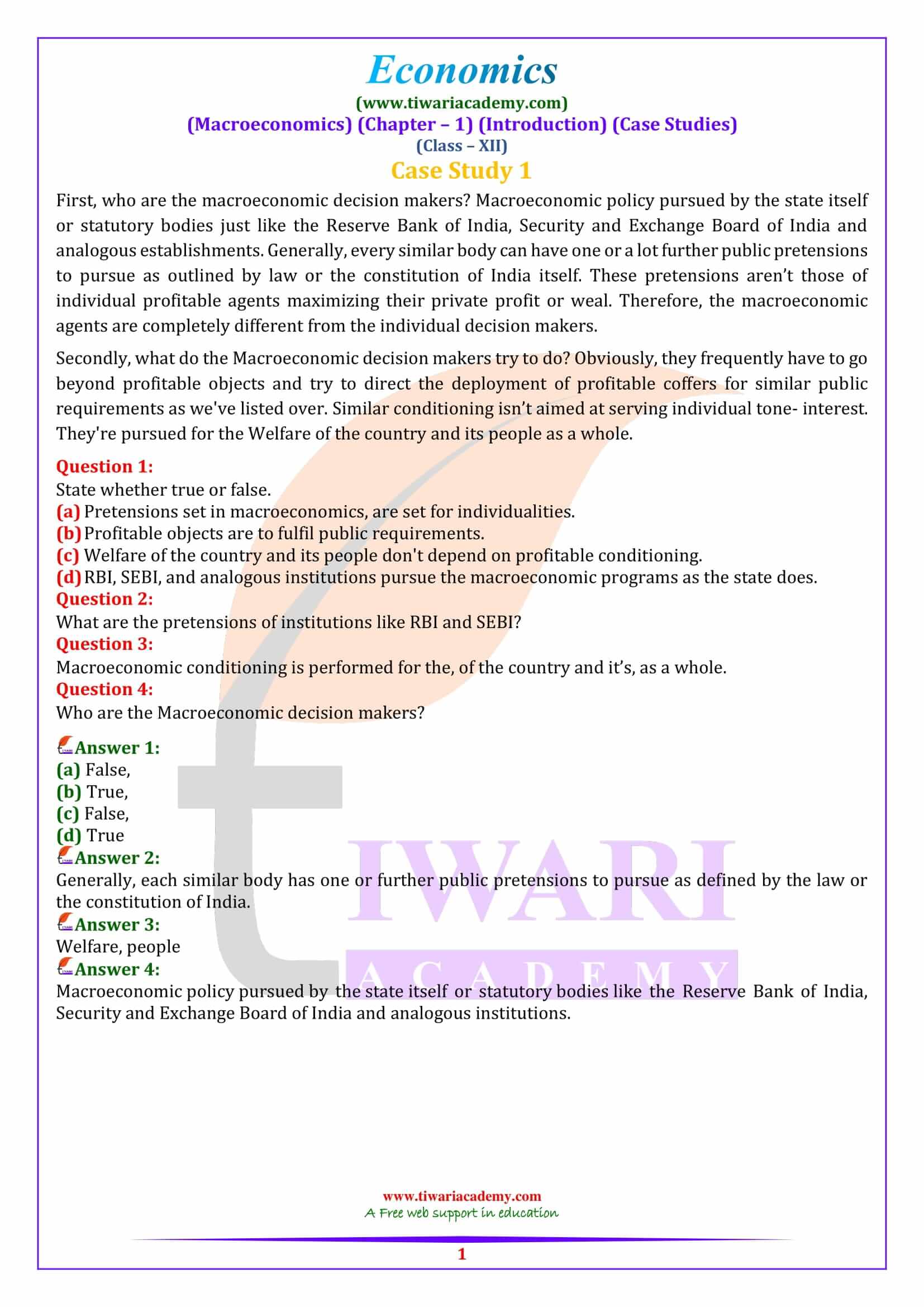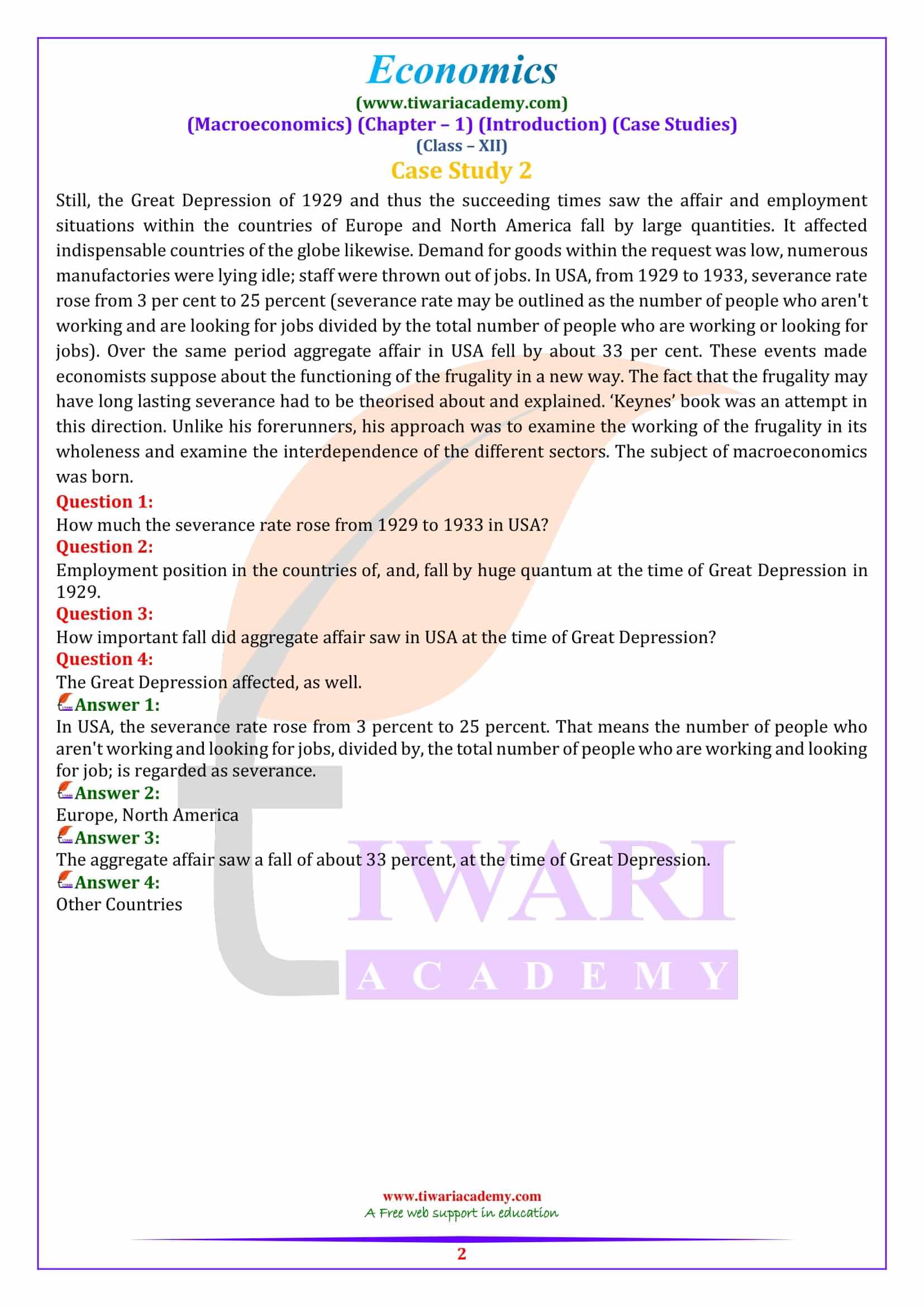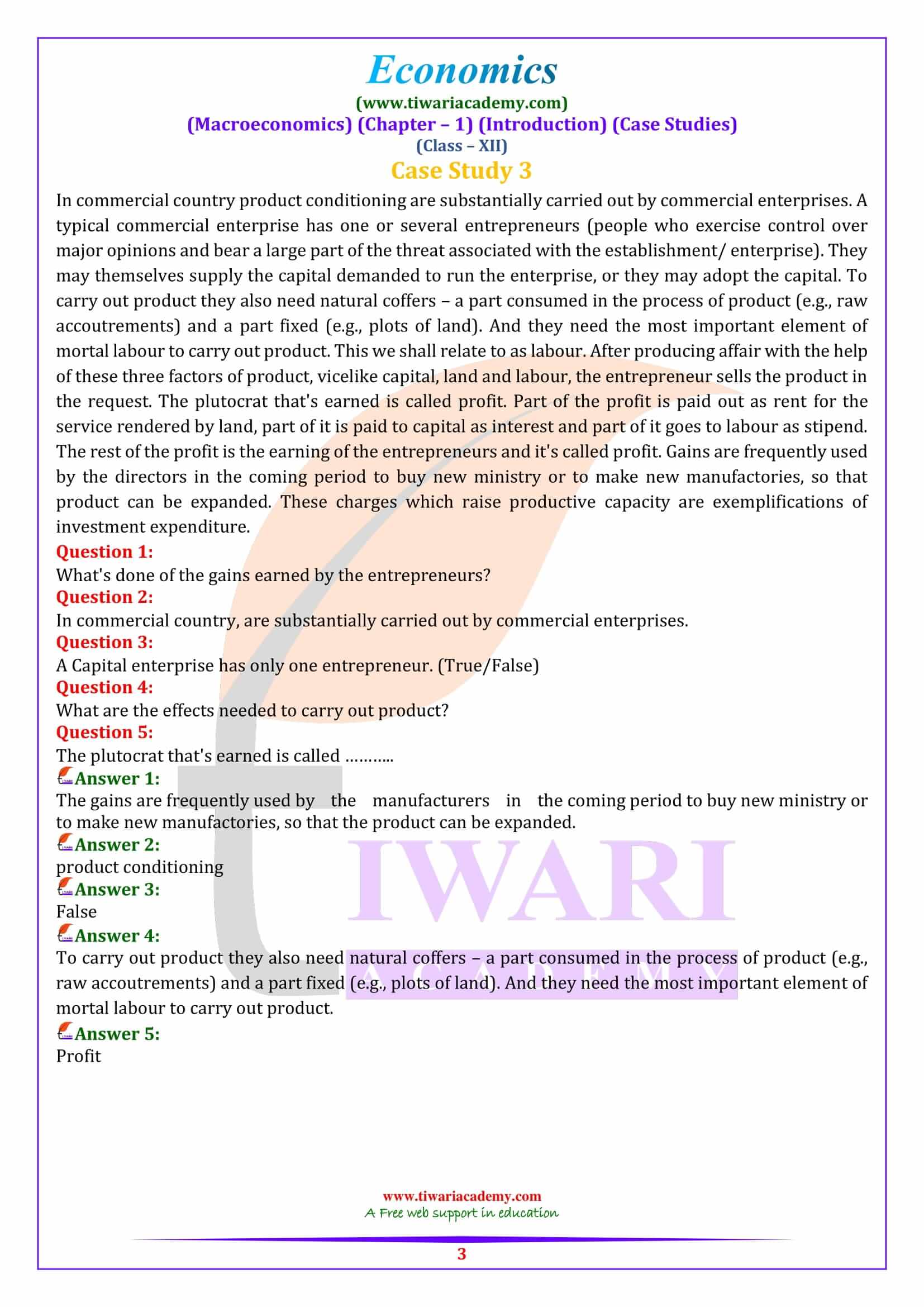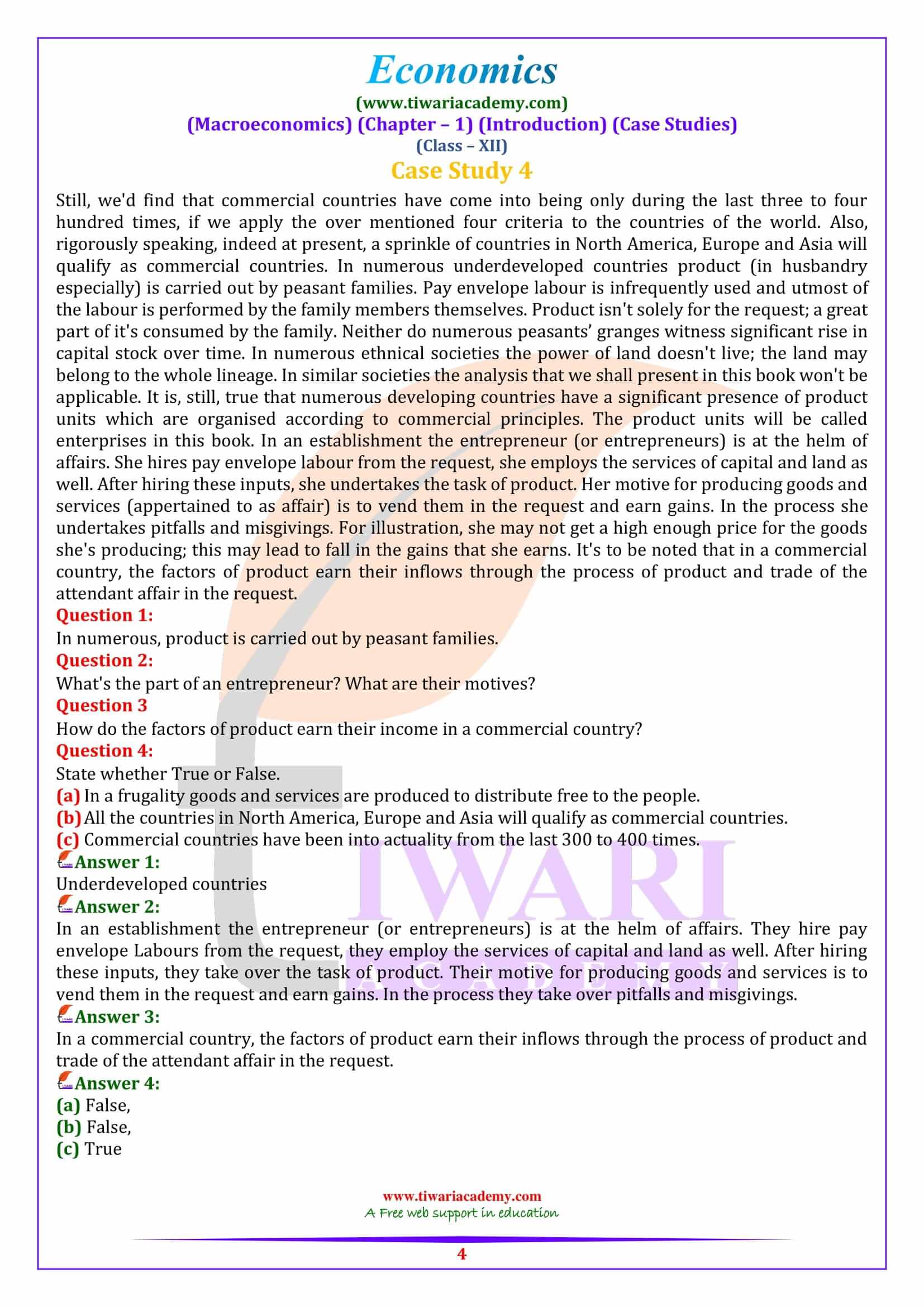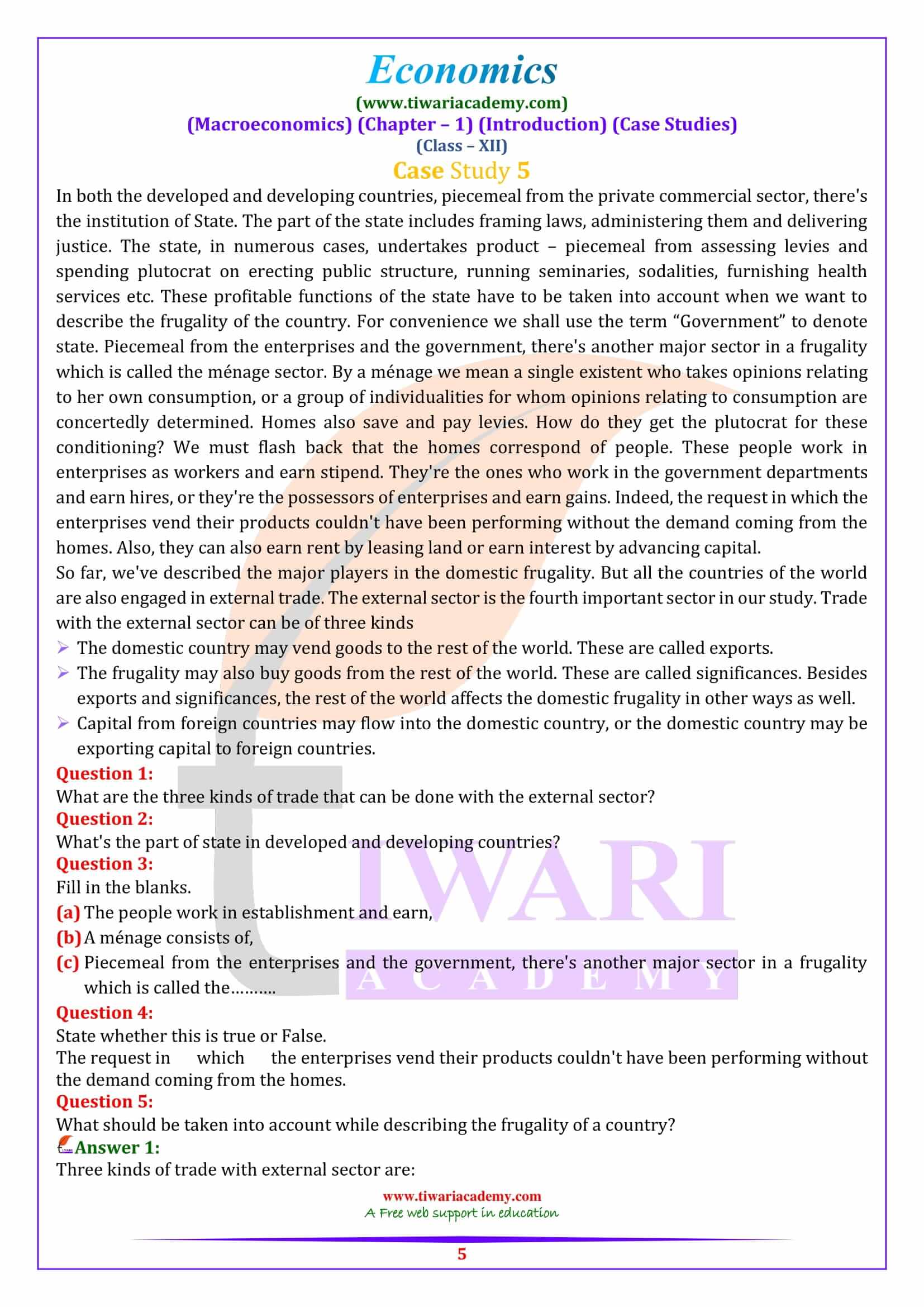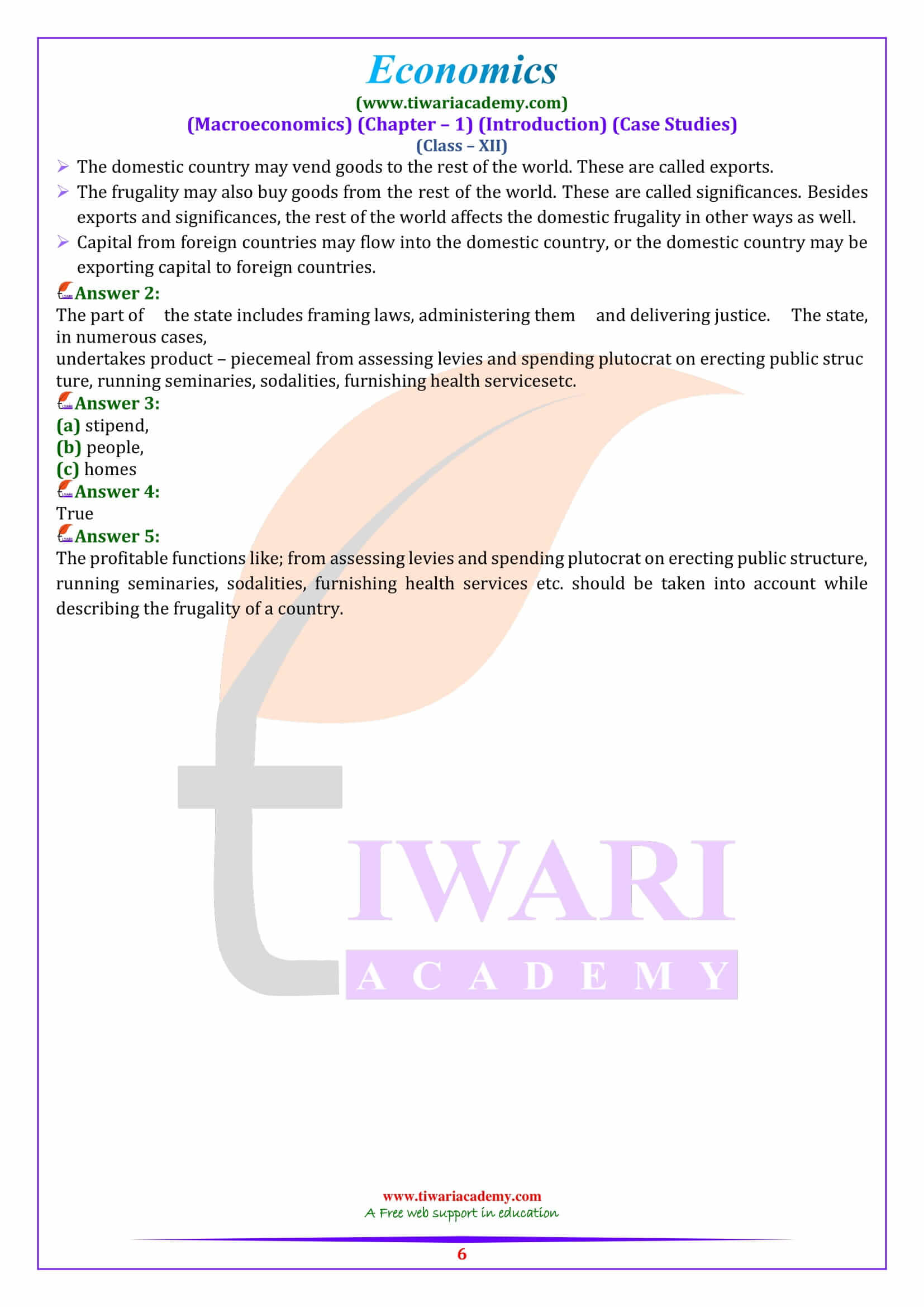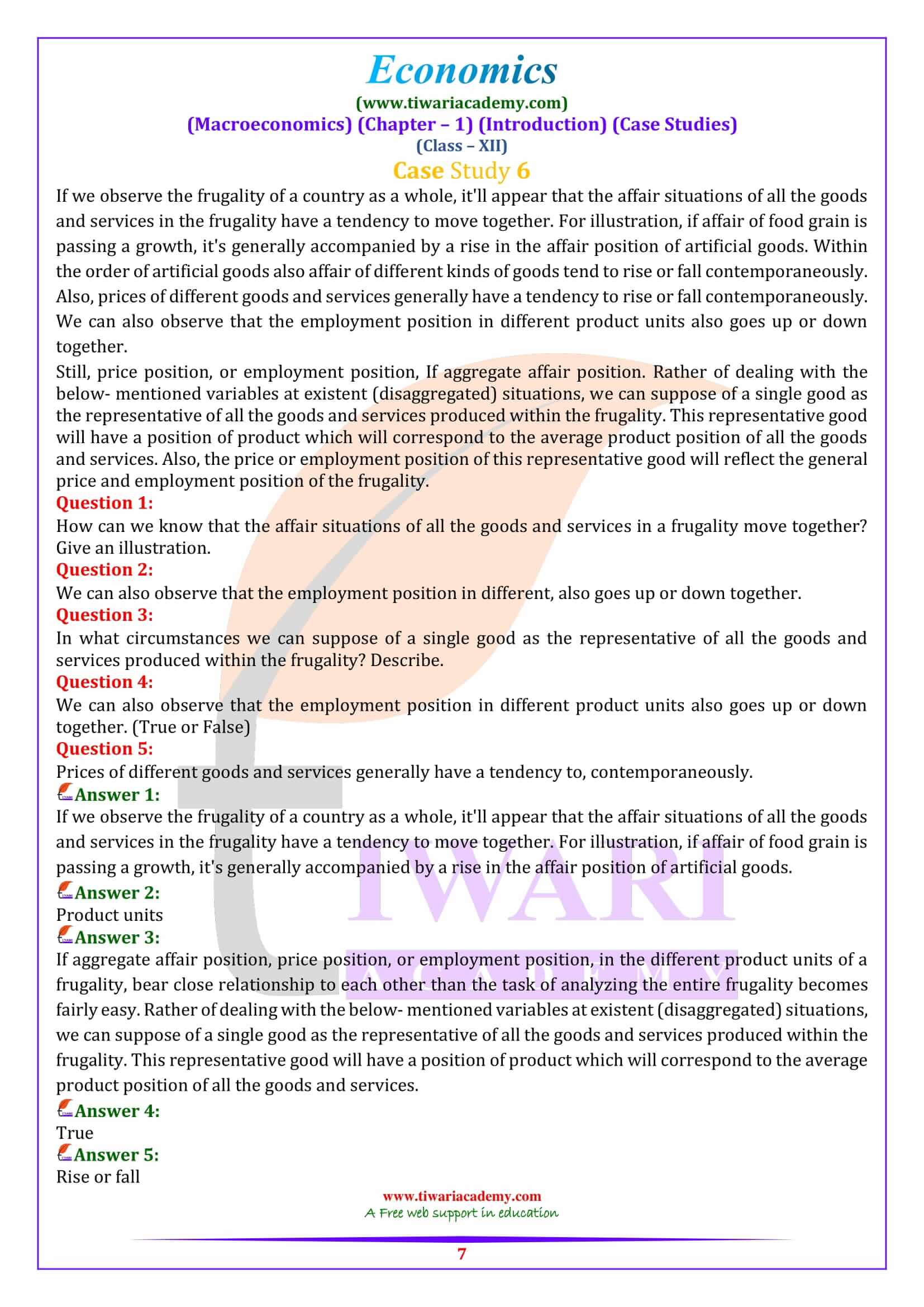NCERT Solutions for Class 12 Macroeconomics Chapter 1 Case Study Questions updated for new academic session 2025-26. Get here all the Case based questions of chapter 1 Introduction with suitable answers with Case Study MCQ and practice questions on Case Studies.
Class 12 Macroeconomics Chapter 1 Case Studies Question Answers
Class 12 Macroeconomics Chapter 1 Case Study: 1
First, who are the macroeconomic decision makers? Macroeconomic policy pursued by the state itself or statutory bodies just like the Reserve Bank of India, Security and Exchange Board of India and analogous establishments. Generally, every similar body can have one or a lot further public pretensions to pursue as outlined by law or the constitution of India itself. These pretensions aren’t those of individual profitable agents maximizing their private profit or weal. Therefore, the macroeconomic agents are completely different from the individual decision makers.
Secondly, what do the Macroeconomic decision makers try to do? Obviously, they frequently have to go beyond profitable objects and try to direct the deployment of profitable coffers for similar public requirements as we’ve listed over. Similar conditioning isn’t aimed at serving individual tone- interest. They’re pursued for the Welfare of the country and its people as a whole.
- Question 1:
State whether true or false.
(a) Pretensions set in macroeconomics, are set for individualities.
(b) Profitable objects are to fulfil public requirements.
(c) Welfare of the country and its people don’t depend on profitable conditioning.
(d) RBI, SEBI, and analogous institutions pursue the macroeconomic programs as the state does. - Question 2:
What are the pretensions of institutions like RBI and SEBI? - Question 3:
Macroeconomic conditioning is performed for the, of the country and it’s, as a whole. - Question 4:
Who are the Macroeconomic decision makers?
- Answer 1:
(a) False,
(b) True,
(c) False,
(d) True - Answer 2:
Generally, each similar body has one or further public pretensions to pursue as defined by the law or the constitution of India. - Answer 3:
Welfare, people - Answer 4:
Macroeconomic policy pursued by the state itself or statutory bodies like the Reserve Bank of India, Security and Exchange Board of India and analogous institutions.
Class 12 Macroeconomics Chapter 1 Case Study: 2
Still, the Great Depression of 1929 and thus the succeeding times saw the affair and employment situations within the countries of Europe and North America fall by large quantities. It affected indispensable countries of the globe likewise. Demand for goods within the request was low, numerous manufactories were lying idle; staff were thrown out of jobs. In USA, from 1929 to 1933, severance rate rose from 3 per cent to 25 percent (severance rate may be outlined as the number of people who aren’t working and are looking for jobs divided by the total number of people who are working or looking for jobs).
Over the same period aggregate affair in USA fell by about 33 per cent. These events made economists suppose about the functioning of the frugality in a new way. The fact that the frugality may have long lasting severance had to be theorised about and explained. ‘Keynes’ book was an attempt in this direction. Unlike his forerunners, his approach was to examine the working of the frugality in its wholeness and examine the interdependence of the different sectors. The subject of macroeconomics was born.
- Question 1:
How much the severance rate rose from 1929 to 1933 in USA? - Question 2:
Employment position in the countries of, and, fall by huge quantum at the time of Great Depression in 1929. - Question 3:
How important fall did aggregate affair saw in USA at the time of Great Depression? - Question 4:
The Great Depression affected, as well.
- Answer 1:
In USA, the severance rate rose from 3 percent to 25 percent. That means the number of people who aren’t working and looking for jobs, divided by, the total number of people who are working and looking for job; is regarded as severance. - Answer 2:
Europe, North America - Answer 3:
The aggregate affair saw a fall of about 33 percent, at the time of Great Depression. - Answer 4:
Other Countries
Class 12 Macroeconomics Chapter 1 Case Study: 3
In commercial country product conditioning are substantially carried out by commercial enterprises. A typical commercial enterprise has one or several entrepreneurs (people who exercise control over major opinions and bear a large part of the threat associated with the establishment/ enterprise). They may themselves supply the capital demanded to run the enterprise, or they may adopt the capital. To carry out product they also need natural coffers – a part consumed in the process of product (e.g., raw accoutrements) and a part fixed (e.g., plots of land). And they need the most important element of mortal labour to carry out product. This we shall relate to as labour.
After producing affair with the help of these three factors of product, vicelike capital, land and labour, the entrepreneur sells the product in the request. The plutocrat that’s earned is called profit. Part of the profit is paid out as rent for the service rendered by land, part of it is paid to capital as interest and part of it goes to labour as stipend. The rest of the profit is the earning of the entrepreneurs and it’s called profit. Gains are frequently used by the directors in the coming period to buy new ministry or to make new manufactories, so that product can be expanded. These charges which raise productive capacity are exemplifications of investment expenditure.
- Question 1:
What’s done of the gains earned by the entrepreneurs? - Question 2:
In commercial country, are substantially carried out by commercial enterprises. - Question 3:
A Capital enterprise has only one entrepreneur. (True/False) - Question 4:
What are the effects needed to carry out product? - Question 5:
The plutocrat that’s earned is called ………..
- Answer 1:
The gains are frequently used by the manufacturers in the coming period to buy new ministry or to make new manufactories, so that the product can be expanded. - Answer 2:
product conditioning - Answer 3:
False - Answer 4:
To carry out product they also need natural coffers – a part consumed in the process of product (e.g., raw accoutrements) and a part fixed (e.g., plots of land). And they need the most important element of mortal labour to carry out product. - Answer 5:
Profit.
Class 12 Macroeconomics Chapter 1 Case Study: 4
Still, we’d find that commercial countries have come into being only during the last three to four hundred times, if we apply the over mentioned four criteria to the countries of the world. Also, rigorously speaking, indeed at present, a sprinkle of countries in North America, Europe and Asia will qualify as commercial countries. In numerous underdeveloped countries product (in husbandry especially) is carried out by peasant families. Pay envelope labour is infrequently used and utmost of the labour is performed by the family members themselves. Product isn’t solely for the request; a great part of it’s consumed by the family. Neither do numerous peasants’ granges witness significant rise in capital stock over time. In numerous ethical societies the power of land doesn’t live; the land may belong to the whole lineage. In similar societies the analysis that we shall present in this book won’t be applicable. It is, still, true that numerous developing countries have a significant presence of product units which are organised according to commercial principles.
The product units will be called enterprises in this book. In an establishment the entrepreneur (or entrepreneurs) is at the helm of affairs. She hires pay envelope labour from the request, she employs the services of capital and land as well. After hiring these inputs, she undertakes the task of product. Her motive for producing goods and services (appertained to as affair) is to vend them in the request and earn gains. In the process she undertakes pitfalls and misgivings. For illustration, she may not get a high enough price for the goods she’s producing; this may lead to fall in the gains that she earns. It’s to be noted that in a commercial country, the factors of product earn their inflows through the process of product and trade of the attendant affair in the request.
- Question 1:
In numerous, product is carried out by peasant families. - Question 2:
What’s the part of an entrepreneur? What are their motives? - Question 3
How do the factors of product earn their income in a commercial country? - Question 4:
State whether True or False.
(a) In a frugality goods and services are produced to distribute free to the people.
(b) All the countries in North America, Europe and Asia will qualify as commercial countries.
(c) Commercial countries have been into actuality from the last 300 to 400 times.
- Answer 1:
Underdeveloped countries - Answer 2:
In an establishment the entrepreneur (or entrepreneurs) is at the helm of affairs. They hire pay envelope Labours from the request, they employ the services of capital and land as well. After hiring these inputs, they take over the task of product. Their motive for producing goods and services is to vend them in the request and earn gains. In the process they take over pitfalls and misgivings. - Answer 3:
In a commercial country, the factors of product earn their inflows through the process of product and trade of the attendant affair in the request. - Answer 4:
(a) False,
(b) False,
(c) True.
Class 12 Macroeconomics Chapter 1 Case Study: 5
In both the developed and developing countries, piecemeal from the private commercial sector, there’s the institution of State. The part of the state includes framing laws, administering them and delivering justice. The state, in numerous cases, undertakes product – piecemeal from assessing levies and spending plutocrat on erecting public structure, running seminaries, sodalities, furnishing health services etc. These profitable functions of the state have to be taken into account when we want to describe the frugality of the country. For convenience we shall use the term “Government” to denote state. Piecemeal from the enterprises and the government, there’s another major sector in a frugality which is called the menage sector. By a menage we mean a single existent who takes opinions relating to her own consumption, or a group of individualities for whom opinions relating to consumption are concertedly determined.
Homes also save and pay levies. How do they get the plutocrat for these conditioning? We must flash back that the homes correspond of people. These people work in enterprises as workers and earn stipend. They’re the ones who work in the government departments and earn hires, or they’re the possessors of enterprises and earn gains. Indeed, the request in which the enterprises vend their products couldn’t have been performing without the demand coming from the homes. Also, they can also earn rent by leasing land or earn interest by advancing capital.
So far, we’ve described the major players in the domestic frugality. But all the countries of the world are also engaged in external trade. The external sector is the fourth important sector in our study. Trade with the external sector can be of three kinds:
- The domestic country may vend goods to the rest of the world. These are called exports.
- The frugality may also buy goods from the rest of the world. These are called significances. Besides exports and significances, the rest of the world affects the domestic frugality in other ways as well.
- Capital from foreign countries may flow into the domestic country, or the domestic country may be exporting capital to foreign countries.
- Question 1:
What are the three kinds of trade that can be done with the external sector? - Question 2:
What’s the part of state in developed and developing countries? - Question 3:
Fill in the blanks.
(a) The people work in establishment and earn,
(b) A menage consists of,
(c) Piecemeal from the enterprises and the government, there’s another major sector in a frugality which is called the………. - Question 4:
State whether this is true or False.
The request in which the enterprises vend their products couldn’t have been performing without the demand coming from the homes. - Question 5:
What should be taken into account while describing the frugality of a country?
- Answer 1:
Three kinds of trade with external sector are:
The domestic country may vend goods to the rest of the world. These are called exports.
The frugality may also buy goods from the rest of the world. These are called significance. Besides exports and significance, the rest of the world affects the domestic frugality in other ways as well.
Capital from foreign countries may flow into the domestic country, or the domestic country may be exporting capital to foreign countries. - Answer 2:
The part of the state includes framing laws, administering them and delivering justice. The state, in numerous cases, undertakes product – piecemeal from assessing levies and spending plutocrat on erecting public structure, running seminaries, sodalities, furnishing health services etc. - Answer 3:
(a) stipend,
(b) people,
(c) homes - Answer 4:
True - Answer 5:
The profitable functions like; from assessing levies and spending plutocrat on erecting public structure, running seminaries, sodalities, furnishing health services etc. should be taken into account while describing the frugality of a country.
